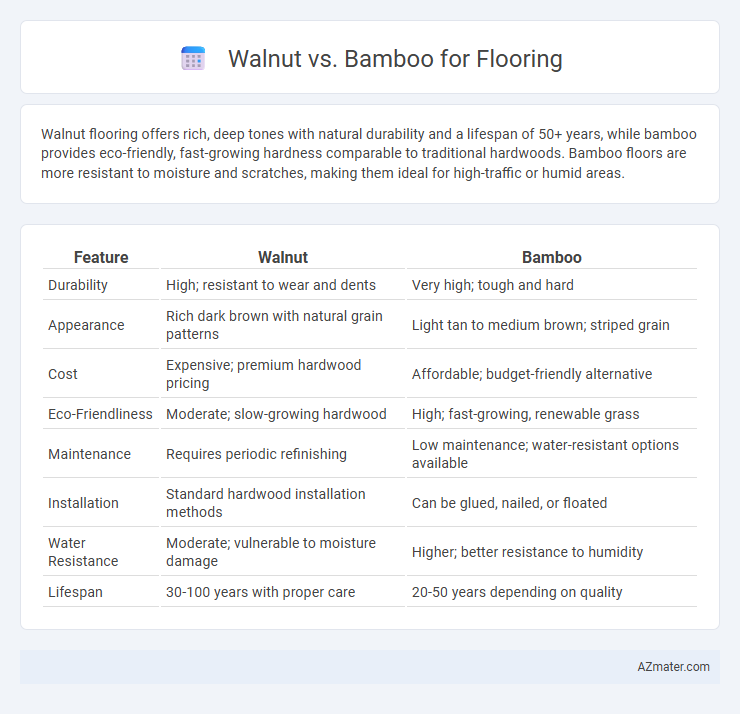Walnut flooring offers rich, deep tones with natural durability and a lifespan of 50+ years, while bamboo provides eco-friendly, fast-growing hardness comparable to traditional hardwoods. Bamboo floors are more resistant to moisture and scratches, making them ideal for high-traffic or humid areas.
Table of Comparison
| Feature | Walnut | Bamboo |
|---|---|---|
| Durability | High; resistant to wear and dents | Very high; tough and hard |
| Appearance | Rich dark brown with natural grain patterns | Light tan to medium brown; striped grain |
| Cost | Expensive; premium hardwood pricing | Affordable; budget-friendly alternative |
| Eco-Friendliness | Moderate; slow-growing hardwood | High; fast-growing, renewable grass |
| Maintenance | Requires periodic refinishing | Low maintenance; water-resistant options available |
| Installation | Standard hardwood installation methods | Can be glued, nailed, or floated |
| Water Resistance | Moderate; vulnerable to moisture damage | Higher; better resistance to humidity |
| Lifespan | 30-100 years with proper care | 20-50 years depending on quality |
Introduction: Walnut vs Bamboo Flooring
Walnut flooring offers rich, dark tones with a natural grain that enhances the warmth and elegance of interiors, making it a popular choice for traditional and modern designs. Bamboo flooring, known for its sustainability and durability, provides a lighter, more uniform appearance with high resistance to moisture and wear, ideal for eco-friendly homes and high-traffic areas. Comparing walnut and bamboo involves evaluating hardness ratings, environmental impact, maintenance, and aesthetic appeal to determine the best fit for specific flooring needs.
Appearance and Aesthetics
Walnut flooring offers a rich, dark brown hue with deep, warm undertones and a striking grain pattern that enhances traditional and rustic interiors. Bamboo flooring presents a lighter, natural look with smooth, linear grain and variations in color from creamy to caramel, lending a modern and eco-friendly aesthetic. Both materials provide distinctive visual appeal, with walnut prized for its elegance and bamboo favored for its contemporary brightness.
Durability and Hardness
Walnut flooring offers a Janka hardness rating of approximately 1,010, making it moderately hard and suitable for residential spaces with medium foot traffic. Bamboo flooring, especially strand-woven bamboo, boasts a higher Janka hardness ranging from 1,400 to 1,500, providing superior durability and resistance to dents and scratches. The denser composition of strand-woven bamboo enhances its longevity compared to walnut, making it a preferable choice for high-traffic or commercial flooring applications.
Environmental Impact and Sustainability
Walnut flooring, derived from slow-growing hardwood trees, has a higher environmental impact due to longer growth cycles and deforestation concerns, whereas bamboo flooring is praised for its rapid renewability, as bamboo can be harvested every 3-5 years without killing the plant. Bamboo's ability to sequester carbon dioxide and its minimal need for pesticides or fertilizers make it a more sustainable option compared to walnut. Certification systems such as FSC (Forest Stewardship Council) help ensure both walnut and bamboo flooring come from responsibly managed sources, but bamboo consistently ranks higher in eco-friendly flooring choices.
Installation Process and Methods
Walnut flooring typically requires professional installation due to its hardness and susceptibility to denting, often using nail-down or glue-down methods for solid wood and click-lock systems for engineered variants. Bamboo flooring offers more versatility with installation, accommodating nail-down, glue-down, and floating floor methods, making it easier for DIY projects. Both materials benefit from acclimatization before installation to ensure stability and reduce expansion or contraction post-installation.
Maintenance and Cleaning Requirements
Walnut flooring requires regular dusting and occasional polishing to maintain its rich, dark appearance, and it is best cleaned with a damp mop using a pH-neutral cleaner specifically designed for hardwood. Bamboo flooring offers greater resistance to moisture and scratches, making it easier to clean with a simple vacuum or dry mop, but it still benefits from periodic deep cleaning with a mild detergent to prevent grime buildup. Both materials demand prompt spill cleanup to avoid damage, though bamboo's natural durability typically lowers overall maintenance efforts compared to walnut.
Cost Comparison
Walnut flooring typically costs between $8 to $14 per square foot due to its rich color and durability, making it a premium choice for hardwood floors. Bamboo flooring ranges from $3 to $8 per square foot, offering a more budget-friendly option while providing similar hardness and sustainability benefits. The price difference is influenced by harvesting methods, processing, and regional availability, making bamboo a cost-effective alternative to walnut for cost-conscious homeowners.
Comfort and Feel Underfoot
Walnut flooring offers a warm, rich texture with a naturally smooth surface that feels soft and inviting underfoot, enhancing comfort in living spaces. Bamboo flooring provides a firm yet resilient feel due to its dense grain structure, which offers excellent shock absorption and durability for high-traffic areas. Both materials deliver distinctive tactile experiences; walnut emphasizes luxurious softness, while bamboo prioritizes a balanced blend of firmness and subtle flexibility.
Moisture and Climate Resistance
Walnut flooring offers moderate moisture resistance but tends to be less suitable for high-humidity environments due to its softer grain and susceptibility to warping. Bamboo flooring, known for its superior moisture and climate resistance, excels in damp or fluctuating conditions because of its dense, durable fibers and natural anti-microbial properties. Choosing bamboo ensures greater longevity and stability in areas prone to moisture variations, whereas walnut requires careful climate control to maintain its structural integrity.
Pros and Cons Summary
Walnut flooring offers rich color variations and exceptional durability, making it ideal for high-traffic areas but tends to be more expensive and softer than some hardwoods, leading to potential dents. Bamboo flooring is eco-friendly, highly renewable, and often more affordable, with good hardness for wear resistance; however, it can be prone to moisture damage and may suffer from inconsistent quality depending on manufacturing processes. Both materials provide unique aesthetics and long-term value, with walnut favoring classic elegance and bamboo appealing to sustainable design preferences.

Infographic: Walnut vs Bamboo for Flooring
 azmater.com
azmater.com